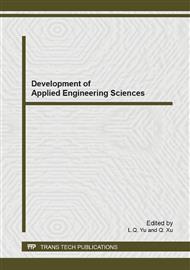[1]
X. Zhang, J. Zhou, J. Guo, Q. Zou, Z. Huang, Vibrant fault diagnosis for hydroelectric generator units with a new combination of rough sets and support vector machine, Expert. Syst. Appl. 39 (2012) 2621-2628.
DOI: 10.1016/j.eswa.2011.08.117
Google Scholar
[2]
X. Chen, J. Zhou, H. Xiao, E. Wang, J. Xiao & H. Zhang, Fault diagnosis based on comprehensive geometric characteristic and probability neural network. Applied Mathematics and Computation, 230(2014) 542-554.
DOI: 10.1016/j.amc.2013.12.122
Google Scholar
[3]
Bing, P., et al., Hydropower Generating Unit's Fault Diagnosis Based on Information Fusion. AUTOMATION OF ELECTRIC POWER SYSTEMS, 2008. 32(13): pp.76-80.
Google Scholar
[4]
M. Zhou, J. Zhou & Z. Liu, Support Vector Machines Based Approach for Hydroelectric Generating Unit Fault Diagnosis. CHINA RURAL WATER AND HYDROPOWER, 2008(1): pp.114-116, 119.
Google Scholar
[5]
Wuke, L., et al., Fault diagnosis of hydroelectric units based on rough set & RBF network. CHINESE JOURNAL OF SCIENTIFIC INSTRUMENT, 2007. 28(10): pp.1806-1810.
Google Scholar
[6]
Bin, H. and Z. Jian-zhong, The data fusion algorithm for hydropower generater unit fault diagnosis. HYDROPOWER AUTOMATION AND DAM MONITORING, 2004. 28(1): pp.12-15.
Google Scholar
[7]
Zhiwei, J.I., H.U. Min and Y. Jian-xin, A survey of feature selection algorithm. ELECTRONIC DESIGN ENGINEERING, 2011. 19(9): pp.46-51.
Google Scholar
[8]
Yong, M., et al., A Survey for Study of Feature Selection Algorithms. PATTERN RECOGNITION AND ARTIFICIAL INTELLIGENCE, 2007. 20(2): pp.211-218.
Google Scholar
[9]
Xu, Y, et al., Summary of feature selection algorithms. Control and Decision, 2012. 27(2): pp.161-166, 192.
Google Scholar
[10]
Juan, W., C.I. Lin-lin and Y. Kang-ze, A Survey of Feature Selection. COMPUTER ENGINEERING AND SCIENCE, 2005. 27(12): pp.68-71.
Google Scholar
[11]
Sun, Z., G. Bebis and R. Miller, Object detection using feature subset selection. Pattern Recognition, 2004. 37(11): pp.2165-2176.
DOI: 10.1016/j.patcog.2004.03.013
Google Scholar
[12]
Narendra, P.M. and K. Fukunaga, A branch and bound algorithm for feature subset selection. 1977. C-26(9): pp.917-22.
DOI: 10.1109/tc.1977.1674939
Google Scholar
[13]
Nakariyakul, S. and D.P. Casasent, Adaptive branch and bound algorithm for selecting optimal features. Pattern Recognition Letters, 2007. 28(12): pp.1415-1427.
DOI: 10.1016/j.patrec.2007.02.015
Google Scholar
[14]
Tsymbal, A. and S. Puuronen. Ensemble feature selection with the simple Bayesian classification in medical diagnostics. in Computer-Based Medical Systems, 2002. (CBMS 2002). Proceedings of the 15th IEEE Symposium on. (2002).
DOI: 10.1109/cbms.2002.1011381
Google Scholar
[15]
Wu B L, Tom A, David F, et al. Comparison of statistical methods for classification of ovarian cancer using mass spectrometry data[J]. Bioinfor-matics, 2003, 19(13): 1636-1643.
Google Scholar
[16]
Furlanello, C., et al., An accelerated procedure for recursive feature ranking on microarray data. Neural Networks, 2003. 16(5–6): pp.641-648.
DOI: 10.1016/s0893-6080(03)00103-5
Google Scholar
[17]
Blum, A.L. and P. Langley, Selection of relevant features and examples in machine learning. Artificial Intelligence, 1997. 97(1–2): pp.245-271.
DOI: 10.1016/s0004-3702(97)00063-5
Google Scholar
[18]
Zhe-Yuan, C., et al., Feature Selection Algorithm Based on Kernel Distance Measure. PATTERN RECOGNITION AND ARTIFICIAL INTELLIGENCE, 2010. 23(2): pp.235-240.
Google Scholar
[19]
Yang, M. and Z. Fang, Feature selection algorithm based on dynamic programming and comentropy. COMPUTER ENGINEERING AND DESIGN, 2010. 31(17): pp.3879-3881, 3894.
Google Scholar
[20]
Ding, C. and H. Peng. Minimum redundancy feature selection from microarray gene expression data. 2003. Piscataway, NJ, USA: IEEE Comput. Soc.
DOI: 10.1109/csb.2003.1227396
Google Scholar
[21]
Hua, J., W.D. Tembe and E.R. Dougherty, Performance of feature-selection methods in the classification of high-dimension data. Pattern Recognition, 2009. 42(3): pp.409-424.
DOI: 10.1016/j.patcog.2008.08.001
Google Scholar
[22]
Zhang, D., S. Chen and Z. Zhou, Constraint Score: A new filter method for feature selection with pairwise constraints. Pattern Recognition, 2008. 41(5): pp.1440-1451.
DOI: 10.1016/j.patcog.2007.10.009
Google Scholar
[23]
Michalak, K. and H. Kwasnicka, Correlation-based feature selection strategy in classification problems. 2006: pp.503-11.
Google Scholar
[24]
Ping, D. and L.I. Ning, A fast SVM-based feature selection method. JOURNAL OF SHANDONG UNIVERSITY(ENGINEERING SCIENCE), 2010. 40(5): pp.60-65.
Google Scholar
[25]
Ji-xiang, Y.E. and G. Xi-ling, A novel fast Wrapper for feature subset selection. JOURNAL OF CHANGSHA UNIVERSITY OF SCIENCE AND TECHNOLOGY(NATURAL SCIENCE), 2010. 07(4): pp.69-73.
Google Scholar
[26]
Li G-Z, Yang J Y. Feature selection for ensemble learning and its application[M]. Machine Learning in Bioinformatics, 2008: 135-155.
DOI: 10.1002/9780470397428.ch6
Google Scholar
[27]
Yu-qing, W., et al., Image quality assessment based on local variance and structure similarity. JOURNAL OF OPTOELECTRONICS·LASER, 2008. 19(11): pp.1546-1553.
Google Scholar
[28]
Yun-wei, P.U., et al., Kernelized Xie-Beni index and its performance. CONTROL AND DECISION, 2007. 22(7): pp.829-832, 835.
Google Scholar
[29]
Zhang, X., et al., Vibrant fault diagnosis for hydroelectric generator units with a new combination of rough sets and support vector machine. Expert Systems with Applications, 2012. 39(3): pp.2621-2628.
DOI: 10.1016/j.eswa.2011.08.117
Google Scholar
[30]
Jia, R. and G. Huang. Hydroelectric generating unit vibration fault diagnosis via BP neural network based on particle swarm optimization. 2009. Piscataway, NJ, USA: IEEE.
DOI: 10.1109/supergen.2009.5347991
Google Scholar


